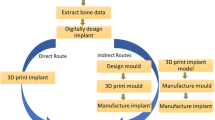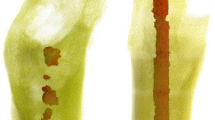Abstract
Purpose
To determine the effects of acrylic acid (AA) grafting by argon plasma treatment and of immobilization of arginine–glycine–aspartic acid (RGD) peptides on fibrovascular ingrowth rate into high-density porous polyethylene (HPPE) anophthalmic orbital implants.
Materials and methods
Sixty rabbits were divided into three groups, with 20 rabbits in each group: (1) control group, rabbits implanted with unmodified HPPE; (2) PAA group, rabbits implanted with HPPE grafted with poly(AA) by argon plasma treatment; (3) RGD group, rabbits implanted with HPPE grafted with AA by argon plasma treatment and subsequently immobilized with RGD peptide. An HPPE spherical implant was put in the abdominal muscles of rabbit. After implantation for 4 weeks, the retrieved implants were sectioned and stained with hematoxylin and eosin (H&E). Blood vessels were counted using CD-31 immunostaining. Cross-sectional areas of fibrovascular ingrowth, blood vessel densities, and host inflammatory response scores were determined for all three groups.
Results
The mean cross-sectional areas of fibrovascularization at 2 and 3 weeks after implantation were the greatest in the RGD group, followed by the PAA group. While minimal fibrovascular ingrowths were noted in all implants at 1 week, all the implants showed nearly complete ingrowth at 4 weeks. Blood vessel densities were the highest in the RGD group, followed by the PAA group at 2, 3, and 4 weeks. The mean inflammation scores of the PAA and RGD groups were less than that of the control group.
Conclusion
Fibrovascularization into HPPE implants was enhanced by surface grafting of AA and further improved by immobilizing RGD peptides onto the grafted AA surfaces. The inflammatory reactions were mild by either technique of surface modification.



Similar content being viewed by others
References
De Potter P, Duprez T, Cosnard G (2000) Postcontrast magnetic resonance imaging assessment of porous polyethylene orbital implant (Medpor). Ophthalmology 107:1656–1660
Blaydon SM, Shepler TR, Neuhaus RW, White WL, Shore JW (2003) The porous polyethylene (Medpor) spherical orbital implant: a retrospective study of 136 cases. Ophthal Plast Reconstr Surg 19:364–371
Rubin PA, Popham JK, Bilyk JR, Shore JW (1994) Comparison of fibrovascular ingrowth into hydroxyapatite and porous polyethylene orbital implants. Ophthal Plast Reconstr Surg 10:96–103
Karesh JW, Dresner SC (1994) High-density porous polyethylene (Medpor) as a successful anophthalmic socket implant. Ophthalmology 101:1688–1695
Morton AD, Nelson C, Ikada Y, Elner VM (2000) Porous polyethylene as a spacer graft in the treatment of lower eyelid retraction. Ophthal Plast Reconstr Surg 16:146–155
Wong JF, Soparkar CN, Patrinely JR (2001) Correction of lower eyelid retraction with high density porous polyethylene: the Medpor lower eyelid spacer. Orbit 20:217–225
Romano JJ, Iliff NT, Manson PN (1993) Use of Medpor porous polyethylene implants in 140 patients with facial fractures. J Craniofac Surg 4:142–147
Ng SG, Madill SA, Inkster CF, Maloof AJ, Leatherbarrow B (2001) Medpor porous polyethylene implants in orbital blowout fracture repair. Eye 15:578–582
Choi JC, Fleming JC, Aitken PA, Shore JW (1999) Porous polyethylene channel implants: a modified porous polyethylene sheet implant designed for repairs of large and complex orbital wall fractures. Ophthal Plast Reconstr Surg 15:56–66
Rubin PA, Bilyk JR, Shore JW (1994) Orbital reconstruction using porous polyethylene sheets. Ophthalmology 101:1697–1708
Perry AC (1990) Integrated orbital implants. Adv Ophthalmic Plast Reconstr Surg 8:75–81
Rosen HM (1991) The response of porous hydroxyapatite to contiguous tissue infection. Plast Reconstr Surg 88:1076–1080
Remulla HD, Rubin PA, Shore JW, Sutula FC, Townsend DJ, Woog JJ, Jahrling KV (1995) Complications of porous spherical orbital implants. Ophthalmology 102:586–593
Sagoo MS, Olver JM (2004) Autogenous temporalis fascia patch graft for porous polyethylene (Medpor) sphere orbital implant exposure. Br J Ophthalmol 88:942–946
Jordan DR, Bawazeer A (2001) Experience with 120 synthetic hydroxyapatite implants (FCI3). Ophthal Plast Reconstr Surg 17:184–190
Rosen HM, McFarland MM (1990) The biologic behavior of hydroxyapatite implanted into the maxillofacial skeleton. Plast Reconstr Surg 85:718–723
Merritt K, Shafer JW, Brown SA (1979) Implant site infection rates with porous and dense materials. J Biomed Mater Res 13:101–108
Kim MJ, Seo ED (2002) Immobilization and grafting of acrylic acid on polyethylene surface by Ar-plasma treatment. Polymer (Korea) 26:279–286
Yang HS, Ahn KD, Han DK (2004) Surface properties and cell adhesion behaviors of PLLA films and dual pore scaffolds grafted with carboxyl acid. Biomater Res 8:135–142
Khang G, Lee SJ, Jeon JH, Lee JH, Lee HB (2000) Interaction of fibroblast cell onto physicochemically treated PLGA surfaces. Polymer (Korea) 24:869–876
Ruoslahti E, Pierschbacher MD (1987) New perspectives in cell adhesion: RGD and integrins. Science 238:491–497
Burdick JA, Anseth KS (2002) Photoencapsulation of osteoblasts in injectable RGD-modified PEG hydrogels for bone tissue engineering. Biomaterials 23:4315–4323
Massia SP, Hubbell JA (1991) Human endothelial cell interactions with surface-coupled adhesion peptides on a nonadhesive glass substrate and two polymeric biomaterials. J Biomed Mater Res 25:223–242
Rubin PA, Nicaeus TE, Warner MA, Remulla HD (1997) Effect of sucralfate and basic fibroblast growth factor on fibrovascular ingrowth into hydroxyapatite and porous polyethylene alloplastic implants using a novel rabbit model. Ophthal Plast Reconstr Surg 13:8–17
Kossovsky N, Millett D, Juma S, Little N, Briggs PC, Raz S, Berg E (1991) In vivo characterization of the inflammatory properties of poly(tetrafluoroethylene) particulates. J Biomed Mater Res 25:1287–1301
Jordan DR, Brownstein S, Dorey M, Yuen VH, Gilberg S (2004) Fibrovascularization of porous polyethylene (Medpor) orbital implant in a rabbit model. Ophthal Plast Reconstr Surg 20:136–143
Guillinta P, Vasani SN, Granet DB, Kikkawa DO (2003) Prosthetic motility in pegged versus unpegged integrated porous orbital implants. Ophthal Plast Reconstr Surg 19:119–122
Anderson RL, Thiese SM, Nerad JA, Jordan DR, Tse D, Allen L (1990) The universal orbital implant: indications and methods. Adv Ophthalmic Plast Reconstr Surg 8:88–99
Mawn LA, Jordan DR, Gilberg S (1998) Scanning electron microscopic examination of porous orbital implants. Can J Ophthalmol 33:203–209
Sarvananthan N, Liddicoat AJ, Fahy GT (1999) Synthetic hydroxyapatite orbital implants: a clinical and MRI evaluation. Eye 13:205–208
Nicaeus TE, Tolentino MJ, Adamis AP, Rubin PA (1996) Sucralfate and basic fibroblast growth factor promote endothelial cell proliferation around porous alloplastic implants in vitro. Ophthal Plast Reconstr Surg 12:235–239
Wang JS, Aspenberg P (1996) Basic fibroblast growth factor promotes bone ingrowth in porous hydroxyapatite. Clin Orthop Relat Res 333:252–260
Bigham WJ, Stanley P, Cahill JM Jr, Curran RW, Perry AC (1999) Fibrovascular ingrowth in porous ocular implants: the effect of material composition, porosity, growth factors, and coatings. Ophthal Plast Reconstr Surg 15:317–325
Sabini P, Sclafani AP, Romo T 3rd, McCormick SA, Cocker R (2000) Modulation of tissue ingrowth into porous high-density polyethylene implants with basic fibroblast growth factor and autologous blood clot. Arch Facial Plast Surg 2:27–33
Soparkar CN, Wong JF, Patrinely JR, Davidson JK, Appling D (2000) Porous polyethylene implant fibrovascularization rate is affected by tissue wrapping, agarose coating, and insertion site. Ophthal Plast Reconstr Surg 16:330–336
Chu PK, Chen JY, Wang LP, Huang N (2002) Plasma-surface modification of biomaterials. Mater Sci Eng R 36:143–206
Chim H, Ong JL, Schantz JT, Hutmacher DW, Agrawal CM (2003) Efficacy of glow discharge gas plasma treatment as a surface modification process for three-dimensional poly (D,L-lactide) scaffolds. J Biomed Mater Res 65A:327–335
Khang G, Lee SJ, Lee JH, Kim YS, Lee HB (1999) Interaction of fibroblast cells on poly(lactide-co-glycolide) surface with wettability chemogradient. Biomed Mater Eng 9:179–187
Lee JH, Lee SJ, Khang G, Lee HB (2000) The effect of fluid shear stress on endothelial cell adhesiveness to polymer surfaces with wettability gradient. J Colloid Interface Sci 230:84–90
Hersel U, Dahmen C, Kessler H (2003) RGD modified polymers: biomaterials for stimulated cell adhesion and beyond. Biomaterials 24:4385–4415
Pierschbacher MD, Ruoslahti E (1984) Cell attachment activity of fibronectin can be duplicated by small synthetic fragments of the molecule. Nature 309:30–33
Sclafani AP, Thomas JR, Cox AJ, Cooper MH (1997) Clinical and histologic response of subcutaneous expanded polytetrafluoroethylene (Gore-Tex) and porous high-density polyethylene (Medpor) implants to acute and early infection. Arch Otolaryngol Head Neck Surg 123:328–336
Horak ER, Leek R, Kl\enk N, LeJeune S, Smith K, Stuart N, Greenall M, Stepniewska K, Harris AL (1992) Angiogenesis, assessed by platelet/endothelial cell adhesion molecule antibodies, as indicator of node metastases and survival in breast cancer. Lancet 340:1120–1124
Kao WJ, Hubbell JA, Anderson JM (1999) Protein-mediated macrophage adhesion and activation on biomaterials: a model for modulating cell behavior. J Mater Sci Mater Med 10:601–605
Acknowledgement
This work was supported by KIST grant 2E19220 from Ministry of Science and Technology, Korea. The authors are grateful to two pathologists, Ju-Han Lee and Ji-Hye Lee at Department of Pathology, School of Medicine, Korea University, who examined the histopathological sections.
Author information
Authors and Affiliations
Corresponding authors
Rights and permissions
About this article
Cite this article
Park, B.W., Yang, H.S., Baek, S.H. et al. The efficacy of acrylic acid grafting and arginine–glycine–aspartic acid peptide immobilization on fibrovascular ingrowth into porous polyethylene implants in rabbits. Graefe's Arch Clin Exp Ophthalmol 245, 855–862 (2007). https://doi.org/10.1007/s00417-006-0475-3
Received:
Revised:
Accepted:
Published:
Issue Date:
DOI: https://doi.org/10.1007/s00417-006-0475-3




